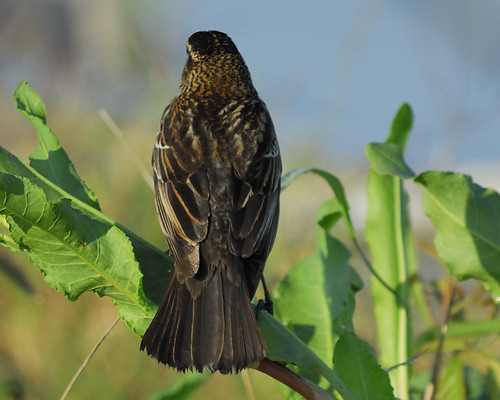tags: Red-Winged Blackbird, Agelaius phoeniceus, birds, mystery bird, bird ID quiz
[Mystery birds] Red-Winged Blackbird, Agelaius phoeniceus, photographed at San Bernard Refuge, Texas. [I will identify this bird for you tomorrow]
Image: Joseph Kennedy, 20 March 2009 [larger view].
Nikon D200, Kowa 883 telescope with tsn-pz camera eyepiece 1/320s f/8.0 at 1000.0mm iso400.
Please name at least one field mark that supports your identification.
Rick Wright, author of Aimophila Adventures and Managing Director of WINGS Birding Tours Worldwide, writes:
A couple of years ago I was leading a field trip, and one of the participants discovered, lurking deep in the cattails, a medium-sized, dark, heavily-patterned bird with a stout bill. I couldn't see it from my angle, but when I asked her whether it was flicking its tail up and giving the low-pitched rubbery call we were hearing, she said yes. And when I told her it was a Red-winged Blackbird, she said I didn't know shoe polish. And when I took time from the field trip to actually find her bird and put a scope on it and show her why it was a Red-winged Blackbird, she told me I knew less than shoe polish.
Well, it was a Red-winged Blackbird, and this mystery bird is one, too. The leaves (rumex?) give us a good gauge of the bird's size -- neither tiny nor gargantuan -- and the overall darkness of the plumage points us towards the icterids pretty quickly. In late March in Texas, the only streaked icterids around are Red-winged Blackbirds. Juvenile cowbirds are paler, rounder, and unlikely to be in existence that early in the year; Bobolinks are yellower, more brightly marked above, and usually still on the wintering grounds in March.
The quiz bird shows a broad, uniformly dark tail and a sooty rump. The mantle is browner, with some subdued rust and white striping visible. The nape is rusty with fine black streaks, and we can just see a bold off-white supercilium on the left side of the head above the dark eye.
The folded wing is rather short. The tertials of the left wing are glossy black with bright rusty margins; those on the right wing look duller and more worn to me. The innermost greater coverts have a similar pattern to that of the tertials, while the outer greaters look dull gray. The white tips of the median coverts form a neat little wingbar, the echo of a male Red-winged Blackbird's yellow patch.
How about Tricolored Blackbird? With trepidation, I'll suggest that the rounded wingtip visible in this view is more like Red-winged than like Tricolored Blackbird, and that the rust on the mantle is also more strongly suggestive of Red-winged than of its California relative. Tail shape is probably useless: this bird's tail feathers are noticeably worn, even ragged at the tip.
That worn tail and the apparent molt limit visible in the greater coverts makes me suspect that this Red-winged Blackbird is in her first spring.
- Log in to post comments


I think that's probably a female red-winged blackbird.
I think that's a female blackbird, too. Overall shape and the intricate coloring.
Well, it's a blackbird that seems to be near molting, indicated by the very worn tail and "buffy" edges of its feathers. It's tail is all wrong for a Grackle. It doesn't look like a Red-Winged Blackbird to me, but I suppose it could be a young male.
However, my guess is a Rusty Blackbird, a non-breeding male, as my Sibley points out the "rusty tertial edges" on the wings, and Texas is in this bird's winter (and therefore non-breeding) range.
The overall streaky appearance of the neck, and the wingbars, speak for a female Red-winged Blackbird. The winter Rusty's are darker and blacker.